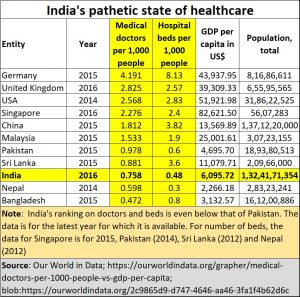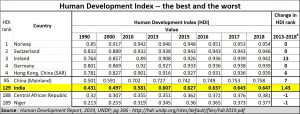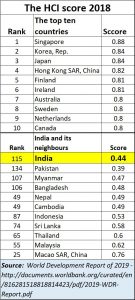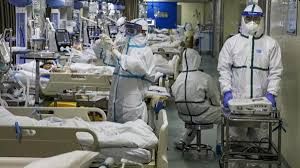https://www.freepressjournal.in/analysis/healthcare-and-medical-education-blighted-vision
Healthcare and medical education mismanaged and misunderstood by the government
RN Bhaskar – June 4, 2020
The government has finally been stirred and shaken by the horrific exposure of the abject health facilities in the country. This was thanks to the brimming over of all major healthcare centres in epidemic centres in India. All media houses covered the terrible state of India’s medicare.
The shameful HDI scores that the World Bank’s UNDP came up with (http://www.asiaconverge.com/2020/05/poor-education-kills-million-of-children-each-year/) and the embarrassingly low ranking of India on the Human Capital Index did little to galvanise the  government to improve its health facilities. As pointed out earlier, India has one of the lowest numbers of both beds and doctors per 1000 people (see chart). Even Pakistan has a better score on these parameters.
government to improve its health facilities. As pointed out earlier, India has one of the lowest numbers of both beds and doctors per 1000 people (see chart). Even Pakistan has a better score on these parameters.
 What is even more scary is a growing consensus that more pandemics will reappear every few years or so. Some could be more virulent and deadly than the coronavirus. Just listen to What Dr. Zarir Udwadia has to say (https://www.youtube.com/watch?v=MtKnnapPPq0).
What is even more scary is a growing consensus that more pandemics will reappear every few years or so. Some could be more virulent and deadly than the coronavirus. Just listen to What Dr. Zarir Udwadia has to say (https://www.youtube.com/watch?v=MtKnnapPPq0).
Even so, the Coronavirus pandemic finally managed to rouse a callous government. But it may come to nothing if the basics are not addressed. To understand this, read on.
 It first began with Finance Minister Nirmala Sitharaman announcing an outlay of Rs 8,100 crore for “boosting” private sector investment in social infrastructure. It offered to do this through the revised VGF (viability gap funding) scheme of the government as part of the Atma Nirbhar Bharat package (http://www.asiaconverge.com/2020/05/atma-nirbhar-bharat-and-healthcare-headed-for-the-icu/).
It first began with Finance Minister Nirmala Sitharaman announcing an outlay of Rs 8,100 crore for “boosting” private sector investment in social infrastructure. It offered to do this through the revised VGF (viability gap funding) scheme of the government as part of the Atma Nirbhar Bharat package (http://www.asiaconverge.com/2020/05/atma-nirbhar-bharat-and-healthcare-headed-for-the-icu/).
The PPP proposal is a joke
Then Niti Aayog, the policy-think-tank of the government wrote to state governments a week later asking states to accelerate the process of setting up of medical colleges. Once again, the PPP (private-public-partnership) model was invoked, and the idea was to augment district hospital facilities with private partners. The Niti Aayog communication stated, ““As you are aware, to address the endemic shortage of qualified doctors across the country especially the Aspirational Districts, NITI Aayog developed and circulated the guidelines for setting up medical colleges through public private partnership.” It went on to add, “The grant can be made available under the applicable VGF scheme of Department of Economic Affairs, Ministry of Finance. Whereby, for social infrastructure projects such as these, the Hon’ble Finance Minister, in ‘the fourth tranche of economic stimulus’, has announced the enhancement of the quantum of VGF to 30 % of the total project cost.” And the joke begins from this point on.
The Niti Aayog exhortation was an echo of the recommendation of a High-Level Group (HLG) that had been formed for the health sector by the 15th Finance Commission. This HLG had recommended the need to incentivise the private sector to open 3,000-5,000 small hospitals in India’s Tier II and III cities in order to overcome the paucity of hospitals in the country. Incidentally, the HLG comprised All India Institute of Medical Sciences Director Randeep Guleria (chairman), Devi Shetty (Narayana Health City), Deelip Govind Mhaisekar (Maharashtra University of Health Sciences), Naresh Trehan (Medanta Medicity), Bhabatosh Biswas (R G Kar Medical College) and K Srinath Reddy (Public Health Foundation of India). Thus, half the members of the HLC were already from the private sector.
As T Sundararaman, former executive director of National Health Systems Resource Centre informed media (https://www.downtoearth.org.in/news/health/shift-health-to-concurrent-list-expert-group-to-finance-commission-68926), “We find there is a conflict of interest in the panel as two of the members are directly linked with the private sector. While we strongly oppose the very proposition, we are not surprised at this recommendation because of the composition of the panel.”
Some of the recommendations of the HLG make sense, though. It stated that the subject of ‘health’ must be transferred to the Concurrent List of the Indian Constitution from the State List. That is a recommendation that the Niti Aayog and the finance minister have been silent about.
Absurd rules
They have also been silent about the rules governing the formation of a private medical college. They are absurd.
In a city you need to have 10 acres of land. Without this your application will not be considered. In non-city areas, the land required will be 20 acres of land. This has been castigated by Dr. Vinay Jain in his 9-minute video (https://www.youtube.com/watch?v=WdDzxFERLak).
Moreover, the rules allow a new medical college to admit only 120 students each year. So, all this investment must be made just to treat 120 students. In four years, the hospital will have just 480 students. Clearly, the rules were designed to promote black-marketing of seats. And, as Jain points out, even a radiology course in Mumbai invites a price tag of Rs.2 crore.
Opening medical colleges in non-urban areas does not make sense either, as there won’t be enough patients. Medical colleges ought to exist in areas where there are lots of patients. As a result, some private colleges in India, actually hire patients to fill the beds when education inspectors come to check if the college is well run.
The government through the finance minister and through Niti Aayog have promoted viability gap funding without changing the basic ground rules first.
Another problem that Jain does not talk about is the non-availability of good teachers for medical colleges. This too has happened because of a policy that allows teaching posts to be reserved for underprivileged categories. Every student knows that if a teacher is not good, the students don’t learn from that teacher. They mock the teacher, bunk classes. That rule too needs to be changed.
It is ironical that a country which demands merit for cricket teams (without any call for reservation) is willing to promote reservations for posts that can affect the very fundamentals of education. Niti Aayog need to consider modifying this rule as well. Are they willing to play with human lives by degrading the quality of future doctors?
A simpler solution
There is a simpler solution. Most government hospitals in Mumbai, Delhi and other major cities are on lands that are centrally located. Many of them were started by the British, Successive governments have thus lived on the largesse of the British and have done little to augment capacities.
Look at these hospitals. Consider the crowds. They are patients waiting to be attended to. They are an opportunity to increase the capacity of beds and out-patient departments government medical colleges. Just let the governments and municipalities allow them to build another 20-40 floors more. Then if there are no funds, get private players to man each super speciality, with the condition at 50% of the beds will be free. Since the land comes free, the private sector must give 50% of the beds free. This is what Masina Hospital in Mumbai is planning to do (http://www.asiaconverge.com/2019/02/masina-hospital-right-path-regain-past-glory/). It was formerly the house of the legendary David Sassoon (http://www.asiaconverge.com/2019/10/david-sassoon-the-biggest-wealth-generator-of-bombay/). By building more floors and then inviting PPP, additional capacities get increased, the costs become lower. Could the finance minister not even consider this possibility?
Such a move will allow for more beds, more capacity for out-patient care, create more doctors at reasonable fee structures, and prepare an India that is truly self-reliant or Atma Nirbhar (http://www.asiaconverge.com/2020/05/atma-nirbhar-bharat-and-healthcare-headed-for-the-icu/) .
|When there are more beds, more doctors, more nurses, three possibilities begin to emerge:
First, students going overseas for higher medical education will choose to stay in India, especially if the standard of education in this country is not allowed to collapse.
Second, with more doctors, and more beds, India could emerge as a hotspot for medical tourism – high quality and low costs in medicare are a winning combination.
Third, as the numbers of doctors and nurses increase, India has the ability to export more nurses and doctors. Both are in huge demand globally. This is more so in countries where populations are ageing.
The failure to do this will cause medical costs to remain high, the movement of students to study medical education overseas will continue to drain our forex reserves, and the prime ministers plan to promote either Ayushman Bharat or Atma Nirbhar schems will come a-cropper.
A high cost fee structure invariably gets doctors to increase their own charges to recover the cost of their investment. India needs a healthcare system that is reasonably priced. Such a system can even take care of the ambitious Ayushman Bharat (http://www.asiaconverge.com/2018/08/ayushman-bharat-great-concept-doctors-overlooked/) It is ridiculous to announce such ambitious healthcare insurance schemes without first creating the right conditions for augmenting the numbers of doctors and beds.
Clearly, Niti Aayog has not done its homework. It has only parroted what other people said without applying its mind. And the FM needs to understand that announcing financing packages without first examining the underlying rules is the wrong way to look at policies. That makes the entire exercise neither sensible, nor atma nirbhar.


































COMMENTS